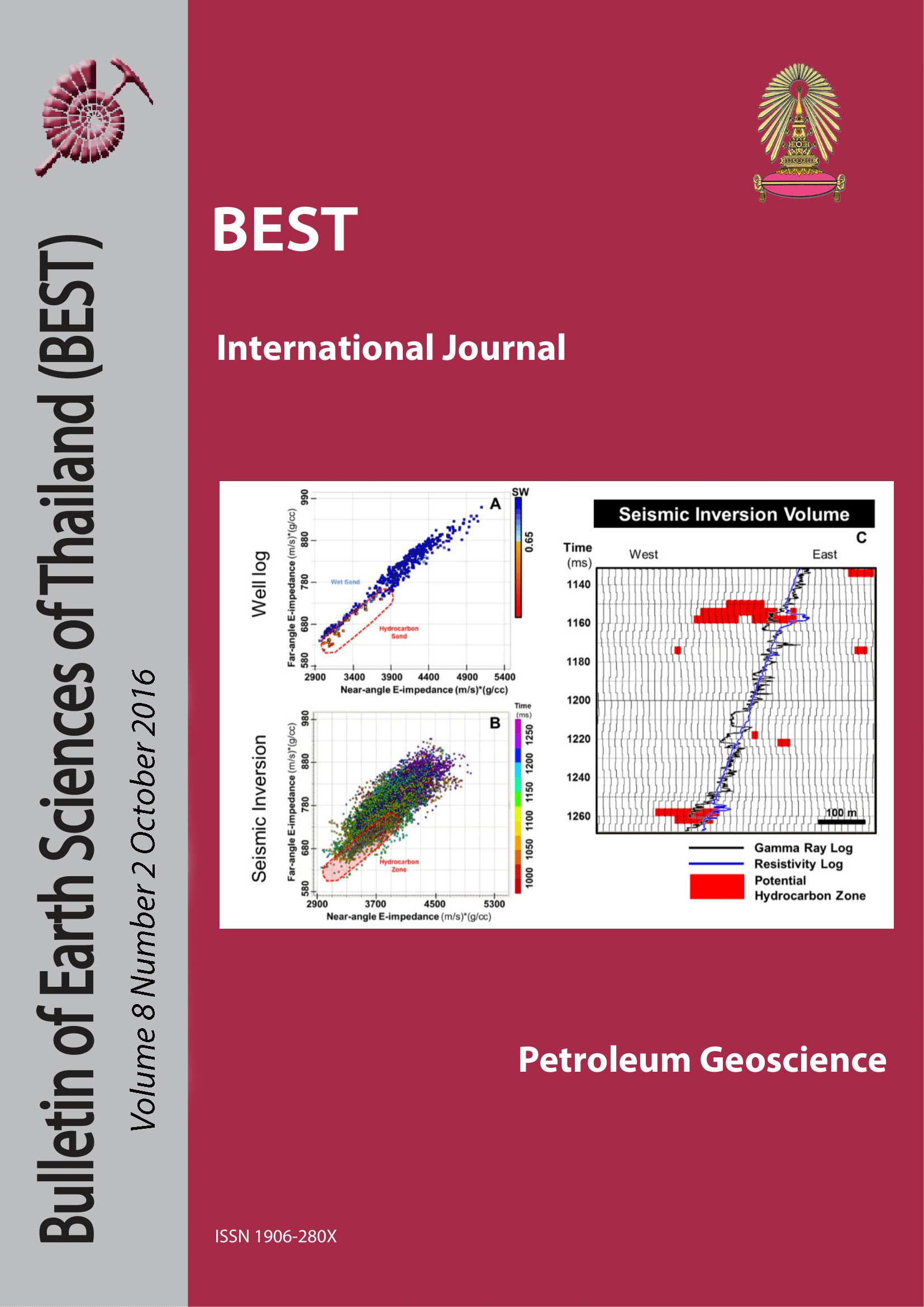POROPERM CONTROLS IN OUTCROP ANALOGS FOR “ORDOVICIAN” FRACTURED CARBONATE RESERVOIRS IN THE SUPHANBURI BASIN,WESTERN THAILAND
Main Article Content
Abstract
Ordovician carbonate outcrops in Suphanburi Province, region of western Thailand are composed of highly metamorphosed carbonates. Previously these rocks were mapped as Ordovician limestones. The lithologies are actually composed of a variety of “Mylonitic marbles,” based on the classification of protolith, texture and mineral composition. The dominant fracture orientation is NW-SE in the studied outcrops. Stable isotopic study focused on calcite-filled fractures (with different orientations) along with calcite-vein cements in various metamorphosed hosts in variably deformed and thrusted Ordovician carbonates of the Thung Song Group. Samples were collected in quarry faces across three areas. Stable isotope crossplots of carbon and oxygen (C-O), using texture-aware isotope samples, define variable, but related, fluid-cement histories. The covariant C-O stable isotope plotfields indicate two trends. The first is a very hot fluid system tied to late mesogenetic/metamorphic alteration driving thermal reequilibration in calcite cement matrix and in calcite filled fractures with NW-SE and NE-SE trends. These are likely orogenic responses driven by the Indosinian (Triassic) orogeny.nThe second trend or plotfield indicates a diagenetic overprint seen in the latest calcite cements from speleothems and calcite filled N-S trending fractures. These samples occur in an uplifted telogenetic setting, driven by Cenozoic tectonics and isostatic uplift. The two distinct C-O signatures suggests a secondary porosity potential, which can be useful as an analogy in subsurface investigations via the integration of values from equivalent drill cuttings, fracture orientation measurements from open hole logs, and identification of unconformities in seismic images. Such integration will better define likely zones of porosity development in possible “uplift plays” in this carbonate unit in the subsurface in the nearby Suphanburi Basin.
Article Details

This work is licensed under a Creative Commons Attribution-NonCommercial-NoDerivatives 4.0 International License.
Copyright © 2008 Department of Geology, Faculty of Science, Chulalongkorn University. Parts of an article can be photocopied or reproduced without prior written permission from the author(s), but due acknowledgments should be stated or cited accordingly.
References
Ahr, W. M., 2008, Geology of carbonate reservoirs: the identification, description, and characterization of hydrocarbon reservoirs in carbonate rocks: Hoboken, N.J., Wiley Inter Science, 277 p.
Allegre, C.J., 2008. Isotope Geology. Cambridge University Press, p. 512. Bucher, K., and R. Grapes, 2011, Petrogenesis of Metamorphic Rocks, Springer, 428 p.
Choquette, P.W., Pray, L.C., 1970. Geologic nomenclature and classification of porosity in sedimentary carbonates. Bull. Am. Assoc. Petrol. Geol. 54, 207-250.
Dietrich, D., McKenzie, J.A., Song, H., 1983. Origin of calcite in syntectonic veins as determined from carbon-isotope ratios. Geology 11, 547-551
DMR, 2014a, Boundary Classification for Geological and Minerals Resources Management, Suphanburi Province, Department of Minerals Resources, p. 111.
DMR, 2014b, Conservation and Management of Geological Resources for Sustainable Development, Suphanburi Province, Department of Minerals Resources.
Eskola P., 1920. The Mineral Facies of Rocks Norsk. Geol. Tidsskr., vol. 6, p. 143.
Hitzman, M.W., 1999. Routine staining of drill core to determine carbonate mineralogy and distinguish carbonate alteration textures. Miner. Deposita 34, 794-798.
Hudson, J.D., 1977. Stable isotopes and limestone lithification. J. Geol. Soc. Lond. 133, 637-660. Elsevier, 656 p.
Hobbs, B., and A. Ord, 2015, Structural Geology: The mechanics of deforming metamorphic rocks. Volume 1. Principles: New York, Elsevier, 656 p.
Kirschner, D.L., Sharp, Z.D., Masson, H., 1995. Oxygen isotope thermometry of quartz- calcite veins: unraveling the thermal- tectonic history of the sub-greenschist facies Morcles nappe (Swiss Alps). Geol. Soc. Am. Bull. 107, 1145-1156.
Lacombe, O., 2010. Calcite twins, a tool for tectonic studies in thrust belts and stable orogenic forelands. Oil and Gas Science and Technology. Rev. IFP Energ. Nouv. 65, 809-839.
Lacroix, B., Trave, A., Buatier, M., Labaume, P., Vennemann, T., Dubois, M., 2014. Syntectonic fluid-flow along thrust faults: example of the South Pyrenean fold-andthrust belt. Mar. Petrol. Geol. 49, 84-98.
Mibei, G., 2014, Introduction to types and classification of rocks: Geothermal Development Company.
Morley, C. K., 2006, Structural geometry and evolution of the Suphan buri, Internal Report, PTT Exploration and Production Co., Ltd.
Nazrul, M., 2015, Fluid evolution through different deformation stage : a carbonate outcrop-based study in the western highland of Thailand, and C. Sangsuwan, 1991, Development of Cenozoic basins in Thailand: Marine and Petroleum Geology, v. 8, p. 84-97.
Taweepornpathomgul, P., 2016, Poroperm controls in an “Ordovician” fractured carbonate reservoir in the Suphanburi basin, western Thailand: using a combination of cuttings, isotopes and FMI, M.SC Research Report Chulalongkorn University.
Ueno, K., Charoentitirat, T., 2011. Carboniferous and Permian. In: Ridd, M.F., Barber, A.J., Crown, M.J. (Eds.), The Geology of Thailand, The Geological Society of London (“Geology of” Series), pp. 71- 136.
Warren, J. K., 2016, Evaporites: A compendium (ISBN 978-3-319-13511-3) Berlin, Springer, 1854 p.
Warren, J., C. Morley, T. Charoentitirat, I. Cartwright, P. Ampaiwan, P. Khositchaisri, M. Mirzaloo, M. Nazrul, A. Panthong, and J. Yingyuen, 2016, Poroperm Evolution through Different Deformation Stages: Stable Isotopes Define Fluid Evolution in Permian and Older Carbonates in Thailand, AAPG Geosciences Technology Workshop, Characterization of Asian Hydrocarbon Reservoirs, Bangkok, Thailand, p. 37
Warren, J. K., 2016, Meta-evaporites, Evaporites: A Geological Compendium, Springer International Publishing Switzerland, p.1375-1468.


